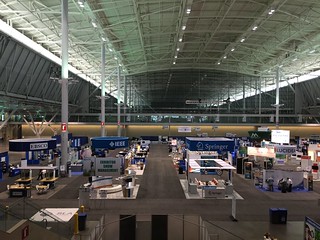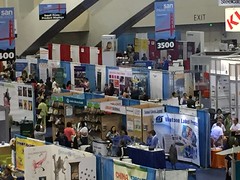
I began attending conferences in the late 1980s. I'm now able to attend several conferences a year and have been able to do so for several years. What is interesting to me - and a bit sad - is that conferences and exhibit halls have not changed in all that time in a major way. There are still many sessions, including some that are delivering old content, others that delivering content to only a few people, and a few that are forward-thinking. There is a large exhibit hall with many organizations displaying their products and services, and likely too few people visiting the booths. There are workshops, which are an additional fee, and a host of receptions, which are sponsored by someone who hopes to gain some marketing advantage.
Those who want to attend a conference need to decide which conference to go to out of the myriad of opportunities. The person has to review the conference program, understand the total cost, and then make a decision. We should note that conferences are expensive and many employers are being selective in the costs they will cover.
Small Changes to the Status Quo
Yes, conference organizers have tried to innovate. For example, once
unconferences became popular, some conferences included unconference-like sessions, but did that last? Did that innovation have a larger impact on how we organize conferences? Seemingly the answer is "no."
We used to rely on conferences to provide continuing education opportunities, which could not be done locally. However, we now can learn via webinars and other means, which makes us less
reliant on conference sessions (as well as other face-to-face training events). In addition, those unique meetings which used to occur at conferences, where people from different geographic regions come together around a specific topic, can now occur using online meeting services.
We now have the ability to view and test new products almost instantly. We can talk to a company by phone or over the Internet, and view a demonstration using Internet technology. We can even negotiate with the company without a face to face meeting. We are no longer reliant on conference exhibit halls in order to see the latest innovations. In fact, the exhibit hall likely contains tools, technologies and services that we're already aware of.
If you look at the number of people, who are attending conferences, you'll notice that the numbers are decreasing. Yes, that is partially due to the economic downturns, but it is also due to people becoming reliant on other means of gaining professional development.
In all these years, we've innovated in other areas which impact conferences. For example, it is now easier for someone to locate and book a place to stay without going through the conference housing bureau. This lessens the conference organizer's ability to negotiate conference space and increases the cost of rooms for those that do use the conference housing service. Conference participants are using
Airbnb,
VRBO and a variety of other services to rent rooms and apartments at a lower rate than the rate charged by the conference hotels.
Changes Need to be More Dramatic
I think we need to dramatically innovate our conferences.
First, we must meet people at that point where they have a need for professional development. That means using different delivery mechanisms for professional development, including webinars and other tools. It might even mean the development of specific tools that don't exist now.
Second, if we are delivering professional development that gives library and information professionals the training that they need when they need it, then we need to understand what the new role is for conferences as the exhibit halls that go with them. What do we need to come together in one spot to learn? What - in terms of what someone could learn - would justify the cost for attending such an event?
I believe that there is a role for librarians in helping to change how we receive professional development.
In part 2, I'll give you the details.








